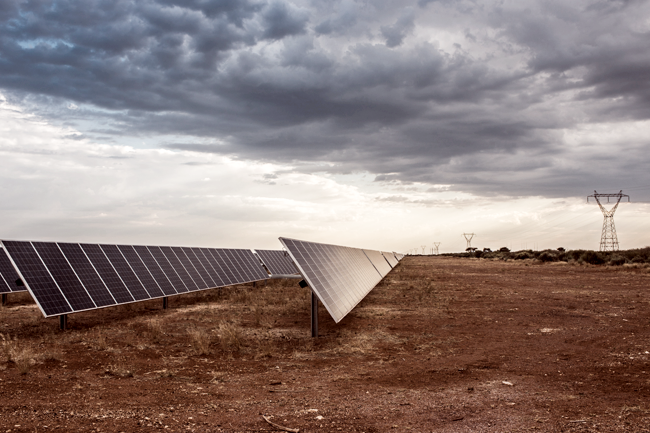Five-year-old orphan Naisanga Esther is the first member of her family to learn to read, and she practises in bed every night. She dreams of becoming a community-health worker in her Ugandan village. Esther went to live in the Kaliro School and Orphanage when her mother died of Aids. It was established as a home and school for orphans but, being so far from the electricity grid, its services ended at sunset.
This all changed, however, when Israel-based NGO Innovation: Africa provided the orphanage with solar technology. Teachers began additional educational programmes and homework help in the evenings.
Since its founding in 2008, Innovation: Africa has completed 90 solar and agricultural projects like this around Africa. Using Israeli solar technology, it has provided schools, orphanages and medical clinics with power to offer evening study, adult education, well-lit night-time medical care and refrigeration for lifesaving medicines and vaccines.
And although it’s only a drop in the ocean of potential, its work shows how small-scale solar energy can bring about fundamental, if not epic, change in everyday lives.
It’s an issue that’s also getting attention at the highest levels. In June, an international body, headed by the former UN secretary general Kofi Annan, urged the west to help Africa finance a new US$20-billion fund to provide low-cost solar panels for Africans without access to energy.
In spite of efforts to get people onto the grid, population growth in Africa has meant that the majority of people still use costly and unhealthy forms of energy for cooking and lighting. No reliable statistics exist on the rise of off-grid renewable energy on a small scale – mostly because projects are often installed by individuals or small NGOs – but the trend is accelerating.
Africa’s huge solar resource, growing energy demands and high unemployment make it an ideal market for solar energy
Energy consultant Chris Ahlfeldt agrees. He’s recently been involved in a number of electricity-sector studies across sub-Saharan Africa, including tariff studies, cost of supply, energy-market restructuring and policy/regulatory reviews for countries such as Namibia, Mozambique, Botswana, Swaziland and South Africa.
Ahlfeldt believes that Africa’s huge solar resource, growing energy demands and high unemployment make it an ideal market for solar energy. He also points to the new levels of affordability of the solar-energy alternative. ‘In sub-Saharan Africa, solar energy is now cheaper than many conventional alternatives such as diesel generators and, sometimes, electricity supplied by the local utility.’
Africa’s limited grid infrastructure also creates more opportunity for distributed and small-scale energy solutions such as solar photovoltaics (PV), which can be built at or near the customer’s site.
The experts are clear on the benefits of choosing solar energy. It is deemed to be cost-competitive, has a quick installation time, has no emissions or noise, and has the ability to scale to meet customers’ demand. Small-scale solar installations and services sector can also boost job creation, which the continent needs.
Then there is the issue of decentralised power generation, which allows end users no choice in how they receive their energy.
With small-scale solar solutions, power generation falls under the control of the end user. Energy is not wasted by transporting it vast distances from generation source to load centre (about 20% to 30% is lost), and the end user has some control over the sustainability aspect of their energy.
But there are downsides too. The intermittent nature of solar is a drawback, but solutions exist, such as micro-grids that use multiple generation sources (for example, wind and solar energy with back-up generators) and/or batteries to store the electricity.
In Africa, one needs only to look around to see solar’s burgeoning presence in thousands of smaller projects. While South Africa, Kenya, Tanzania and Ghana are leading the way, there are examples of best practice dotted all over the continent.
On a larger scale, Africa’s largest microgrid showcases the huge potential for solar in distributed applications. The installation on Annobón Island off Equatorial Guinea uses 5 MW of solar power, with battery storage to provide constant 24-hour electricity for the entire island of 5 000 residents.
‘Solarpreneurs’ are selling solar lamps and kits in their spaza shops, while children gather under solar-powered street lights
Solar panel company Solarcentury is set to design and construct Africa’s largest solar carport on the uppermost storey of a car park at Garden City Mall, part of the new 32-acre integrated residential, retail park, hotel and office development on Nairobi’s Thika superhighway.
In Hargeisa, Somaliland, Edna Adan University Hospital runs on solar power. As with all hospitals, a lot of specialised equipment depends on electricity – imaging machines, oxygen concentrators, anaesthesia equipment, theatre lights and baby incubators. But the prohibitive cost of electricity in the country has forced administrators to find an alternative.
Donors and experts came to the hospital’s aid, and in April this year, the solar panels on its roof went live. The hospital does not have a battery system, so it can’t store the energy, but during peak daylight hours it delivers what is needed for operating requirements. It now saves US$10 000 a year on its electricity costs.
In East Africa, Dutch energy services company Devergy devised a reliable, affordable electricity service for low-income Tanzanians in Matipwili village, based on village-sized energy micro-grids. These provide solar power to households and businesses, and users can connect lights and appliances such as radios, TVs and fridges.
Kenyan firm M-KOPA Solar has developed a pay-as-you-go energy for off-grid customers. Since its commercial launch in October 2012, M-KOPA has provided more than 200 000 homes in Kenya, Tanzania and Uganda with solar power, and is adding more than 500 new homes each day.
In Napuu, in rural Kenya, a Japanese government-funded water project is bringing running water to the village for the first time. Giant solar panels create energy to pump the water from deep underground. Previously, villagers had to travel long distances to find water and it would often be contaminated.
‘Solarpreneurs’ are also thriving, selling solar lamps and kits in their tiny spaza shops, while children gather under solar-powered street lights.
Tanzanian company Juabar builds and operates a network of solar-charging kiosks that it leases to entrepreneurs, who then offer electricity services to their communities.
In South Africa, commercial properties such as offices and shopping centres with solar rooftops are popping up all over the country.
Simon Haw, an energy-sector analyst and specialist project developer for solar-energy plants in South Africa, runs a company called SOLA Future Energy. It has completed projects in Cape Town for Black River Park in Observatory, the Cape Quarter in Green Point, and head offices for Clicks, Woolworths and Takealot, among others.
In KwaZulu-Natal, the eThekwini municipality announced recently that it would invest ZAR8.7 million in solar PV panels at the Moses Mabhida Stadium, uShaka Marine World, Kings Park swimming pool, the Metro Police headquarters, eThekwini Water and Sanitation’s customer service block and Loram House, home to Durban’s strategic projects unit.
Among scores of examples in Johannesburg, the Gauteng provincial government is forging ahead with its ZAR11.2 billion plan, unveiled in late 2013, to install rooftop solar panels on its buildings in Gauteng.
The South African government is also beginning to recognise the value of solar technology. When the energy crisis began in 2008, there was zero provision for PVs in its integrated resource plan (where the government maps out the energy it wants to deploy).
The South African PV industry Association (SAPVIA) aggressively lobbied government to include PVs. According to Haw, SAPVIA has since grown from three companies to over 100.
‘It has spawned a solar industry in South Africa, and already the South African REIPPP [Renewable Energy Independent Power Producer Procurement] programme has a target of about 8 GW of solar power, and is almost half way to procuring that,’ he says.
Haw believes that solar technology – developed and fine-tuned in Europe and the US – is almost at the point of maximum efficiency, with the focus now on how to produce it more cost effectively, use less energy during production, as well as on production methods to bring the costs down even further.
He says that South Africa is at the start of a big curve. ‘We’re going to find big uptake in the next five to 10 years in rooftop PVs, on a commercial and industrial scale, which will then trickle down to residential. The load shedding events could fast-track everything.
‘While Africa is not leading technology innovation, it has the potential to create a huge market, to make use of and integrate this technology. This is how it will benefit,’ he says.
Naysayers claim this is a long way off. In a New York Times interview, John Maina, executive co-ordinator of Kenyan NGO Sustainable Community Development Services, said that small entrepreneurs and organisations ‘don’t have the purchasing power or connections to place bulk orders themselves for distant manufacturers. We can’t get supply’.
In the same article, Minoru Takada, chief of the United Nations Development Programme’s sustainable energy programme, said that while off-grid was the answer for the poor, people who controlled the funding need to see this as a viable option.
While it may not yet be a revolution, Africa’s massive energy need and untapped solar resource potential are laying the groundwork for growth and change in the solar space.
















